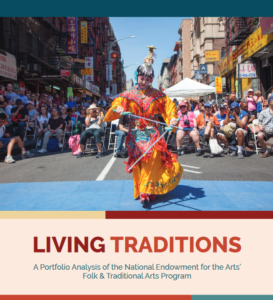November
2019
November 6, 2019
NASAA News and Current Information
NASAA 2019 Leadership Institute Proceedings & Photos
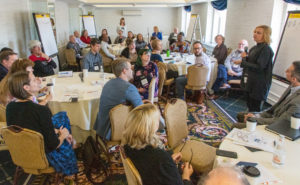
Photo: GeorgeLong.com
The NASAA 2019 Leadership Institute, hosted by the Rhode Island State Council on the Arts in Providence last month, immersed participants in sessions and workshops aimed at developing their skills and knowledge as public funders and arts advocates in their states. Peruse the proceedings of the conference—including a photo album, presentation materials, session notes and more. Thanks to all who joined us!
New NASAA Board Members
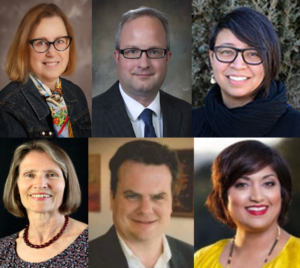 At the 2019 Leadership Institute, NASAA members elected a new chair and five new members to its board of directors. Nebraska Arts Council Executive Director Suzanne Wise (top left) was elected chair, and the newly elected board members are (clockwise from top center) Pennsylvania Council on the Arts Executive Director Karl Blischke, First Peoples Fund Vice President of Programs and Operations Mary V. Bordeaux, MUSE Research Principal Ivonne Chand O’Neal, Louisiana State Arts Council Member Gene Meneray, and ArtsWA Executive Director Karen Hanan. We welcome these exemplary leaders and look forward to working with our 2020 board. Learn more about the NASAA Board of Directors.
At the 2019 Leadership Institute, NASAA members elected a new chair and five new members to its board of directors. Nebraska Arts Council Executive Director Suzanne Wise (top left) was elected chair, and the newly elected board members are (clockwise from top center) Pennsylvania Council on the Arts Executive Director Karl Blischke, First Peoples Fund Vice President of Programs and Operations Mary V. Bordeaux, MUSE Research Principal Ivonne Chand O’Neal, Louisiana State Arts Council Member Gene Meneray, and ArtsWA Executive Director Karen Hanan. We welcome these exemplary leaders and look forward to working with our 2020 board. Learn more about the NASAA Board of Directors.
Better Together
NASAA is a mighty community! From California to Connecticut, Minnesota to Mississippi, American Samoa to Puerto Rico, and everywhere in between, we are a family of innovators, problem solvers and doers. NASAA brings us together, which makes our voices louder, our work stronger and our impact greater. This is why we need you to support NASAA. We’re asking for your participation during our Better Together campaign, now through December 31, to help raise $25,000. Whether large or small, every gift adds up! Please do your part and give today, or watch for postal mail and e-mail in the coming weeks. Thank you!
Preparing Students through STEAM Education
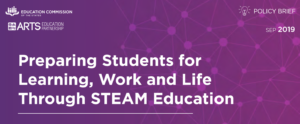 The Education Commission of the States (ECS) worked with the Arts Education Partnership on a new policy brief, Preparing Students for Learning, Work and Life Through STEAM Education, to address questions surrounding state policies on STEAM (science, technology, engineering, arts and math) education. Questions tackled include: What does high-quality STEAM education look like? How do STEM and STEAM education differ? How is STEAM different from arts integration? What skills and abilities does STEAM foster? What careers does STEAM support? The brief identifies barriers and gaps to high-quality STEAM programs and ways state leaders can overcome those barriers.
The Education Commission of the States (ECS) worked with the Arts Education Partnership on a new policy brief, Preparing Students for Learning, Work and Life Through STEAM Education, to address questions surrounding state policies on STEAM (science, technology, engineering, arts and math) education. Questions tackled include: What does high-quality STEAM education look like? How do STEM and STEAM education differ? How is STEAM different from arts integration? What skills and abilities does STEAM foster? What careers does STEAM support? The brief identifies barriers and gaps to high-quality STEAM programs and ways state leaders can overcome those barriers.
America’s Most Arts-Vibrant Communities
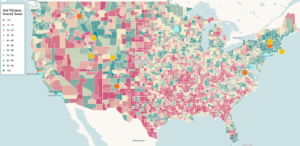 The 2019 Arts Vibrancy Index Report has been released by SMU DataArts, the National Center for Arts Research. It lists the top 40 most arts-vibrant cities in the country, with separate rankings given to large, medium and small cities. The vibrancy index is measured by supply of total arts providers, demand of total nonprofit arts dollars in the community, and public support as state and federal arts funding.
The 2019 Arts Vibrancy Index Report has been released by SMU DataArts, the National Center for Arts Research. It lists the top 40 most arts-vibrant cities in the country, with separate rankings given to large, medium and small cities. The vibrancy index is measured by supply of total arts providers, demand of total nonprofit arts dollars in the community, and public support as state and federal arts funding.
Living Traditions: The National Endowment for the Arts Folk & Traditional Arts Program
Living Traditions: A Portfolio Analysis of the National Endowment for the Arts’ Folk & Traditional Arts Program takes a deep dive into the agency’s Folk & Traditional Arts grant and fellowship awards from 2013 to 2015. It is the first study of its type in the history of the program. The analysis found that awards reach a high proportion of rural residents, high-poverty areas, and historically underserved or marginalized communities. Awards contribute to engaging the public and documenting folk and traditional arts and help to foster strategic partnerships for promoting and sustaining the folk and traditional arts.
Trends in Creative Placemaking on Problem Properties
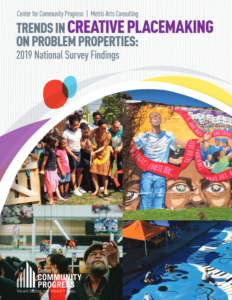 Following 2018 research on creative placemaking on vacant properties, Community Progress recently published Trends in Creative Placemaking on Problem Properties: 2019 National Survey Findings. Community Progress conducted a national survey of practitioners and interviews of eight survey participants to explore the importance of five themes about creative placemaking on problem properties. In addition to highlighting models of creative placemaking, the study found that only 20% of the respondents said that residents were involved in all phases of the project, which indicates there is room for improvement when it comes to ensuring a community-centered process.
Following 2018 research on creative placemaking on vacant properties, Community Progress recently published Trends in Creative Placemaking on Problem Properties: 2019 National Survey Findings. Community Progress conducted a national survey of practitioners and interviews of eight survey participants to explore the importance of five themes about creative placemaking on problem properties. In addition to highlighting models of creative placemaking, the study found that only 20% of the respondents said that residents were involved in all phases of the project, which indicates there is room for improvement when it comes to ensuring a community-centered process.
Heran Sereke-Brhan Is Interim Executive Director in DC
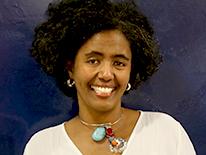 Heran Sereke-Brhan is the interim executive director of the DC Commission on the Arts and Humanities (CAH). Sereke-Brhan has been senior grants officer for the agency since 2017. Prior to joining CAH, she served as deputy director for the Mayor’s Office on African Affairs. Over the past two decades, Sereke-Brhan has worked at a number of cultural and educational institutions, including the Harn Museum at the University of Florida, Addis Ababa University and the Smithsonian’s National Museum of African Art. She holds a Ph.D. in history with a minor in African art history from Michigan State University.
Heran Sereke-Brhan is the interim executive director of the DC Commission on the Arts and Humanities (CAH). Sereke-Brhan has been senior grants officer for the agency since 2017. Prior to joining CAH, she served as deputy director for the Mayor’s Office on African Affairs. Over the past two decades, Sereke-Brhan has worked at a number of cultural and educational institutions, including the Harn Museum at the University of Florida, Addis Ababa University and the Smithsonian’s National Museum of African Art. She holds a Ph.D. in history with a minor in African art history from Michigan State University.
Farewell to Paul Pietsch
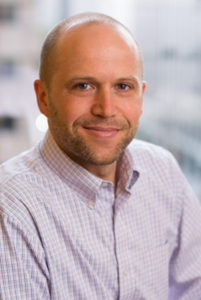 Research Manager Paul Pietsch departed NASAA in October. Paul joined NASAA in this role in 2012, leading qualitative research efforts focused on programmatic and policy trends in state arts agencies. For NASAA, he wrote a number of nationally influential white papers on topics that included arts based rural development, arts in health care, creative aging, arts and the military, the creative economy, public art and diversity in the arts. He also tracked state legislation pertaining to the arts and highlighted innovative state arts agency practices in the monthly State to State column of NASAA Notes. Prior his tenure with NASAA, Paul managed the research efforts of the Association for Demand Response and Smart Grid as well as the Demand Response and Smart Grid Coalition. He has worked as a writer and fundraiser at Harvard University, Dartmouth College and the Smithsonian National Postal Museum. Paul is an artist with an M.F.A. and a graduate certificate in arts management from American University in Washington, D.C. He is a faculty member of the Washington Studio School, facilitates life drawing groups, and has served on the Artists’ Advisory Council of the Washington Project for the Arts and the board of directors of Art Enables, an art gallery and vocational arts program for artists with disabilities. We wish Paul all good success in his new position as senior manager of research & analysis for the Partnership for Public Service.
Research Manager Paul Pietsch departed NASAA in October. Paul joined NASAA in this role in 2012, leading qualitative research efforts focused on programmatic and policy trends in state arts agencies. For NASAA, he wrote a number of nationally influential white papers on topics that included arts based rural development, arts in health care, creative aging, arts and the military, the creative economy, public art and diversity in the arts. He also tracked state legislation pertaining to the arts and highlighted innovative state arts agency practices in the monthly State to State column of NASAA Notes. Prior his tenure with NASAA, Paul managed the research efforts of the Association for Demand Response and Smart Grid as well as the Demand Response and Smart Grid Coalition. He has worked as a writer and fundraiser at Harvard University, Dartmouth College and the Smithsonian National Postal Museum. Paul is an artist with an M.F.A. and a graduate certificate in arts management from American University in Washington, D.C. He is a faculty member of the Washington Studio School, facilitates life drawing groups, and has served on the Artists’ Advisory Council of the Washington Project for the Arts and the board of directors of Art Enables, an art gallery and vocational arts program for artists with disabilities. We wish Paul all good success in his new position as senior manager of research & analysis for the Partnership for Public Service.
In this Issue
From the President and CEO
State to State
- Rhode Island: Arts and Health Network Artist in Residence Program
- Louisiana: Veterans Songwriting Workshop
- Hawaiʻi: Young Artists of Hawaiʻi
Legislative Update
Announcements and Resources
More Notes from NASAA
Research on Demand
SubscribeSubscribe
×
To receive information regarding updates to our newslettter. Please fill out the form below.

